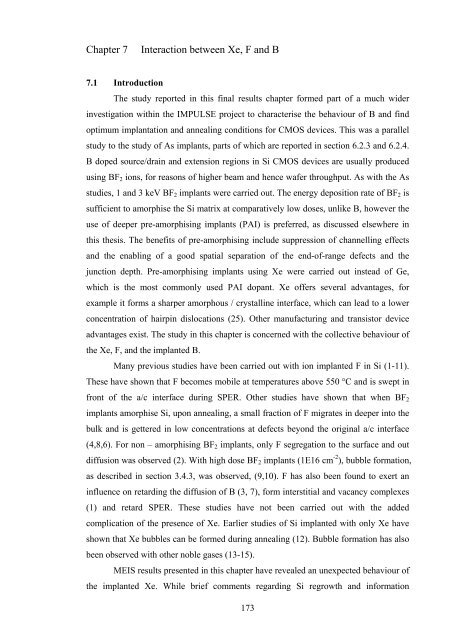Damage formation and annealing studies of low energy ion implants ...
Damage formation and annealing studies of low energy ion implants ...
Damage formation and annealing studies of low energy ion implants ...
Create successful ePaper yourself
Turn your PDF publications into a flip-book with our unique Google optimized e-Paper software.
Chapter 7 Interact<strong>ion</strong> between Xe, F <strong>and</strong> B<br />
7.1 Introduct<strong>ion</strong><br />
The study reported in this final results chapter formed part <strong>of</strong> a much wider<br />
investigat<strong>ion</strong> within the IMPULSE project to characterise the behaviour <strong>of</strong> B <strong>and</strong> find<br />
optimum implantat<strong>ion</strong> <strong>and</strong> <strong>annealing</strong> condit<strong>ion</strong>s for CMOS devices. This was a parallel<br />
study to the study <strong>of</strong> As <strong>implants</strong>, parts <strong>of</strong> which are reported in sect<strong>ion</strong> 6.2.3 <strong>and</strong> 6.2.4.<br />
B doped source/drain <strong>and</strong> extens<strong>ion</strong> reg<strong>ion</strong>s in Si CMOS devices are usually produced<br />
using BF2 <strong>ion</strong>s, for reasons <strong>of</strong> higher beam <strong>and</strong> hence wafer throughput. As with the As<br />
<strong>studies</strong>, 1 <strong>and</strong> 3 keV BF2 <strong>implants</strong> were carried out. The <strong>energy</strong> deposit<strong>ion</strong> rate <strong>of</strong> BF2 is<br />
sufficient to amorphise the Si matrix at comparatively <strong>low</strong> doses, unlike B, however the<br />
use <strong>of</strong> deeper pre-amorphising <strong>implants</strong> (PAI) is preferred, as discussed elsewhere in<br />
this thesis. The benefits <strong>of</strong> pre-amorphising include suppress<strong>ion</strong> <strong>of</strong> channelling effects<br />
<strong>and</strong> the enabling <strong>of</strong> a good spatial separat<strong>ion</strong> <strong>of</strong> the end-<strong>of</strong>-range defects <strong>and</strong> the<br />
junct<strong>ion</strong> depth. Pre-amorphising <strong>implants</strong> using Xe were carried out instead <strong>of</strong> Ge,<br />
which is the most commonly used PAI dopant. Xe <strong>of</strong>fers several advantages, for<br />
example it forms a sharper amorphous / crystalline interface, which can lead to a <strong>low</strong>er<br />
concentrat<strong>ion</strong> <strong>of</strong> hairpin dislocat<strong>ion</strong>s (25). Other manufacturing <strong>and</strong> transistor device<br />
advantages exist. The study in this chapter is concerned with the collective behaviour <strong>of</strong><br />
the Xe, F, <strong>and</strong> the implanted B.<br />
Many previous <strong>studies</strong> have been carried out with <strong>ion</strong> implanted F in Si (1-11).<br />
These have shown that F becomes mobile at temperatures above 550 °C <strong>and</strong> is swept in<br />
front <strong>of</strong> the a/c interface during SPER. Other <strong>studies</strong> have shown that when BF2<br />
<strong>implants</strong> amorphise Si, upon <strong>annealing</strong>, a small fract<strong>ion</strong> <strong>of</strong> F migrates in deeper into the<br />
bulk <strong>and</strong> is gettered in <strong>low</strong> concentrat<strong>ion</strong>s at defects beyond the original a/c interface<br />
(4,8,6). For non – amorphising BF2 <strong>implants</strong>, only F segregat<strong>ion</strong> to the surface <strong>and</strong> out<br />
diffus<strong>ion</strong> was observed (2). With high dose BF2 <strong>implants</strong> (1E16 cm -2 ), bubble <strong>format<strong>ion</strong></strong>,<br />
as described in sect<strong>ion</strong> 3.4.3, was observed, (9,10). F has also been found to exert an<br />
influence on retarding the diffus<strong>ion</strong> <strong>of</strong> B (3, 7), form interstitial <strong>and</strong> vacancy complexes<br />
(1) <strong>and</strong> retard SPER. These <strong>studies</strong> have not been carried out with the added<br />
complicat<strong>ion</strong> <strong>of</strong> the presence <strong>of</strong> Xe. Earlier <strong>studies</strong> <strong>of</strong> Si implanted with only Xe have<br />
shown that Xe bubbles can be formed during <strong>annealing</strong> (12). Bubble <strong>format<strong>ion</strong></strong> has also<br />
been observed with other noble gases (13-15).<br />
MEIS results presented in this chapter have revealed an unexpected behaviour <strong>of</strong><br />
the implanted Xe. While brief comments regarding Si regrowth <strong>and</strong> in<strong>format<strong>ion</strong></strong><br />
173
















